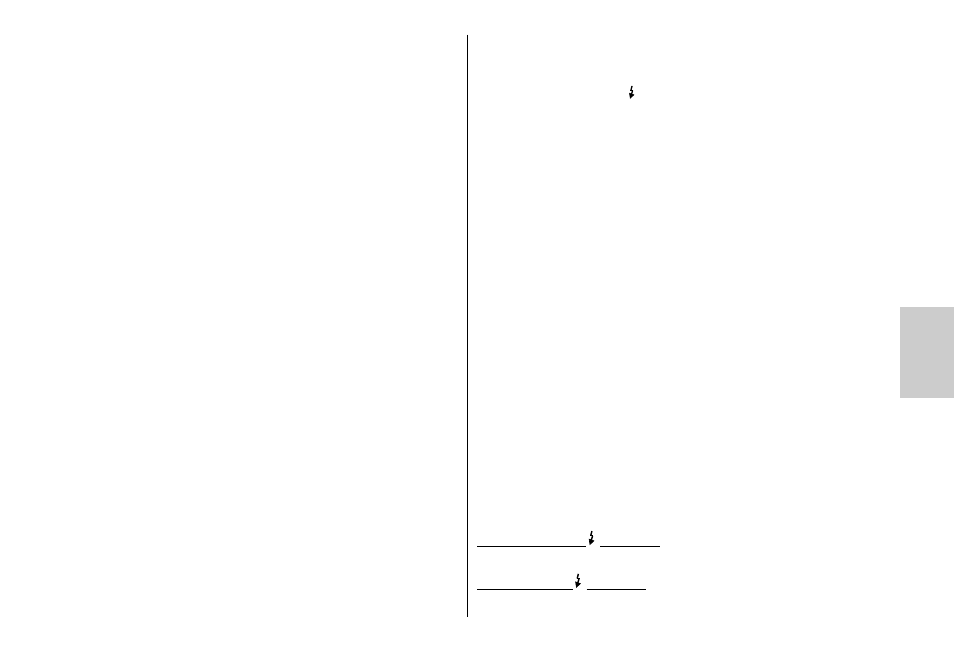Metz MECABLITZ 44 AF-3/4 Nikon User Manual
Page 75

75
ķ
The “REAR” symbol for 2nd curtain synchronisation is no longer indicated by
the mecablitz display. The mecablitz is then once again synchronised with the
first curtain (normal) synchronisation.
mecablitz 44 AF-3N with cameras from Group B
With cameras from Group B (see Table 1), the REAR function has to be set
directly on the camera (for details refer to the camera’s operating instruc-
tions). “REAR” is then not displayed by the mecablitz or “REAR” cannot be
selected on the mecablitz!
mecablitz 44 AF-4N with cameras from Group A and B
The REAR function must always be set directly on the camera (for details refer
to the camera’s operating instructions). The REAR function is not displayed by
the mecablitz.
mecablitz 44 AF-4N with Nikon F801, F801s, F4, F4s
The settings are completed in the same manner as with the mecablitz 44 AF-3N
in conjunction with cameras from Group A.
4.8.3 Slow synchronisation / SLOW
In certain operating modes, some cameras (e.g. F5, F100, F90X, F90, F80,
F70, F65) permit slow flash synchronisation (“SLOW”) which will provide
added prominence to the background at lower ambient light levels. This is
achieved by matching the shutter speed to the ambient light. Accordingly,
shutter speeds slower than the flash sync speed (e.g. shutter speeds up to
30s) are automatically adjusted by the camera. Some cameras automatically
activate SLOW synchronisation in connection with certain programs (e.g.
night shots program, etc.) or permit slow synchronisation to be set (see
camera’s instruction manual). No settings are made on the mecablitz nor is
there any display for this mode.
Use a tripod to avoid camera shake with slow shutter speeds!
☞
5. mecablitz and camera functions
5.1 Flash readiness indication
The flash readiness symbol lights up on the mecablitz when the flash capa-
citor is charged, thereby indicating that flashes can be fired for the next shot.
Flash readiness is also transmitted to the camera for corresponding display in
the viewfinder (see 5.3).
If a picture is shot before flash readiness is signalled in the camera’s view-
finder, then the flash unit will not be triggered so that the exposure may be
incorrect if the camera has changed over to flash sync speed in the meantime
(see 5.2).
5.2 Automatic flash sync speed control
Depending upon the camera model and camera mode, the shutter speed is
changed to flash sync speed when flash readiness is reached (see the came-
ra’s operating instructions).
Shutter speeds faster than the flash sync speed cannot be set or will automati-
cally be converted to flash sync speed. Various cameras have a sync speed
range, e.g. 1/30th sec. to 1/125th sec. (see the camera’s operating instruc-
tions). The actual sync speed set by the camera depends upon the camera
mode, the ambient light and the focal length of the lens used.
Shutter speeds slower than the flash sync speed can be set, depending upon
the given camera model and the selected flash synchronisation (see also
4.8.2 and 4.8.3).
Various digital cameras permit the flash to be used at all shutter
speeds. Automatic sync speed conversion then proves to be unneces-
sary and will not be performed.
5.3 Displays in the camera viewfinder
Green flash symbol illuminated
Command to switch on or use the flash unit.
Red flash symbol illuminated
The flash unit is ready for firing.
☞
